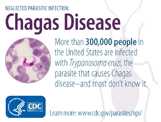Diagnosis
Parasitologic methods, including identification of trypomastigotes in blood by microscopy, are most effective during acute infections. Circulating parasite levels decrease rapidly within a few months and are undetectable by most methods during the chronic phase.
Diagnosis of chronic Chagas disease is made by serologic tests for antibody to the parasite. A single test is not sufficiently sensitive and specific to make the diagnosis. For this reason, the standard approach is to apply two or more tests that use different techniques and/or that detect antibodies to different antigens. Two commonly used techniques are enzyme-linked immunosorbent assay (ELISA) and immunofluorescent antibody test (IFA). To increase accuracy of diagnosis, careful consideration of the patient’s history to identify possible risks for infection may be helpful.
In December 2006, the U.S. Food and Drug Administration approved the first screening test for blood donations; a second screening test made by another manufacturer was approved in 2010. A supplemental test with greater specificity is used to assist with donor counseling regarding Chagas disease. Donors who are positive on the screening test can no longer donate blood, regardless of their supplemental test or additional testing result. Donors are contacted by the blood center and notified about the results of the blood donation testing and positive donors are requested to contact their physician. Blood donor screening tests are not appropriate for clinical diagnostic purposes and additional testing is indicated.
For questions regarding diagnostic considerations, contact Parasitic Diseases Inquiries (404-718-4745; e-mail chagas@cdc.gov).
More on: Chagas Disease Diagnosis [DPDx]
- Page last reviewed: February 5, 2014
- Page last updated: February 5, 2014
- Content source:



 ShareCompartir
ShareCompartir